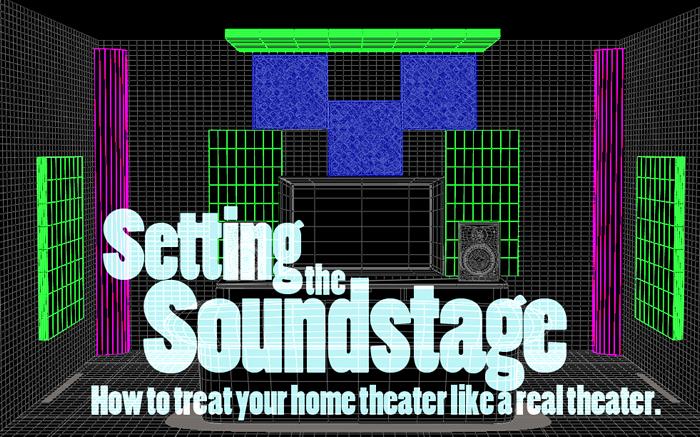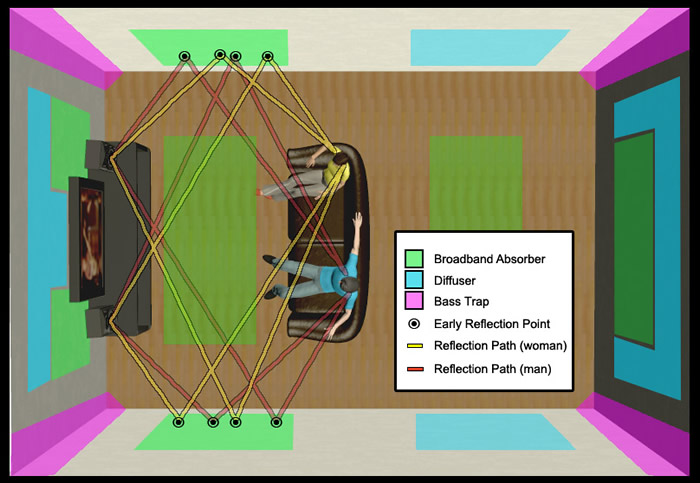|

Modern AVR’s include all kinds
of wizardry for speaker setup, positioning and
room equalization. Anyone in the know will tell
you that room EQ hardware and software should be
a last resort. Correct acoustical treatments
will pay much bigger dividends.
If you are like many people,
you have recently upgraded your home theater, or
you’re getting ready to do so. During this
process you’ve likely learned that the speakers
in the TV are sub-par and you should upgrade
your audio experience to include an external
sound system. This has become common practice
and common knowledge. What you haven’t learned,
and which is probably even more important, is
how to upgrade the room itself.
One of the things people
overlook when trying to make a home theater, is
that a real theater pays a lot of attention to
the design and treatment of the theater
environment. They have good left-right design
symmetry (see the diagram for a sample home
theater layout). A good theater also has
acoustically treated the space so that people
can hear everything that is happening, from
anywhere in the theater. This article will
teach you some of the tricks of getting that
great big theater soundstage into your home
theater.

Bass
Traps – the low-down solution.
Low frequency problems are
common to almost any room, regardless of size.
The good news is that, most of the time, the
solution is simple: put
bass traps
in the corners of the room. This is one place
where it pays to put a little extra in the
budget. Corners are defined as the intersection
of two or more surfaces. There are not just
corners at the end of each wall, but also along
the floor and ceiling where the walls intersect
them. The more corner you cover with a good
trap, the better bass response you get – it’s
that simple. Bass loves the corners, and by
putting bass
traps there, you keep the bass crisp and
natural. If bass frequencies are allowed to
build in the corners, it causes the bass
frequencies to become muddy and undefined – trap
them.
Some
bass traps
work double duty as
broadband
absorbers as well, which can keep your costs
down when considering covering a bunch of square
footage with absorbers.
Bass traps
alone can solve many problems in your room, and
due to the simplicity of the implementation, I
recommend you start with these first - at least
fill the four main corners.
Foam works. But this is a
theater, not a studio.
Fabric wrapped
absorbers look as good as they sound, and
Geometrix™ by Acoustics First, fit the
corners like a glove. Pick a fabric and get
some quarter rounds to fill your corners –
that’s it.
Broadband
Absorption – tame the ring.
Another common problem in home
environments can be easily verified with a clap
test. Go into your room and clap your hands.
Most likely you will hear more than just the
initial clap. Depending on the severity of the
problem, you will hear a flutter, ring, or echo
after the initial *pop*. This is caused by the
sound waves bouncing around off the hard
surfaces of the room and returning to your ears
after a delay - the more times they bounce
without losing energy, the longer the delay. The
best way to remove energy from these waves is to
use broadband absorption, but where do you put
them?
More than likely, your TV and
sound system are going to be in a fixed
position, and your listening position will also
be fixed – so the early reflection surfaces
should be easy to locate. You will need a
friend for this activity, a mirror, and a
pencil. Have your friend place the mirror flat
against the side wall and move it around until
you can see the speakers in the reflection from
your seat – then mark the wall. This is where
you are going to place the absorber. The diagram
shows a good place to start looking for these
reflection paths. Repeat this for all the walls
from all the seats.
What you are looking to create
is a reflection free zone, which basically
means, wherever the sound could bounce off a
surface and get to your ears, we are going to
absorb energy from it. You can spend a good
deal of time on this, but this is the only step
that requires this time and effort, so make it
count. Sound travels in all directions from
the speaker, including behind it, so put
absorbers
behind it on the wall. Don’t forget the floors,
ceiling, and the wall behind you – sound will
bounce off those as well.
This simple process will show
you where you need to treat. Hang broadband
absorbers over
all the early reflection points – left, right,
front and back.
Absorber
clouds should be hung on the ceiling, and
place a nice thick carpet on the floor.
Placement is the first key to getting this
reflection free zone. The second is the right
choice of absorber.
To match your
fabric wrapped bass traps, the simple choice
is get some more
panels wrapped
in fabric. The
Sonora® line of
broadband absorbing panels coordinate with
the
bass traps, and come in a plethora of sizes
and mounting options to work in your space.
Need 2’x4’ behind the speakers, 4’x4’ on the
sidewalls, 2’x6’ on the back wall, and a 2’x6’
ceiling
cloud - all in material that match those
bass
traps? Done.
Finally, use broadband
absorption with caution, specifically using too
much. If you plan on covering more than 50% of
your walls with this stuff, you’re going to
notice a muffled almost claustrophobia inducing
deadness. We are not trying to suck the life
out of the room. We are just trying to take
enough energy away from those early reflections
to keep the focus on the initial sound produced
by the speakers.
Diffusers
– put life back into your space.
The steps we have taken up to
this point have been using absorption to control
excess energy that can have an adverse effect on
the listening environment. We have removed the
unwanted direct reflections and we have tamed
the bass, but there is something more we can do
to give life to this room –
diffusion.
Diffusion
will give us something we couldn’t attain
through absorption
- a sense of open space. Even after treating
with absorbers,
there are still areas of the room where sound
waves will sit, because your room is a fixed box
with fixed speakers.
Diffusers
scatter the energy, creating ambiance with
residual energy, like sitting quietly in a
forest – the energy around you being
directionless, omni-present, and spacious. This
simple step does not remove energy from your
room, but redistributes it into a soundscape
that can make you forget you are in a room at
all.
There are many ways to diffuse
the sound and coordinate with your room, from
the fabric covered
HiPer™ Panel and
Double
Duty Diffusers™, to the striking line of
Art
Diffusors® like the
Model C, which can be painted to match your
décor.
Advances in
acoustic
treatments are being made all the time,
bridging form with function, creating products
as visually stunning as they sound – and helping
your theater, or any theater, be the best that
it can be. So use these tips to set up your
home
theater like a real theater, and experience
the difference a soundstage upgrade makes.
About James
When not writing, Mr.
DeGrandis is a Microsoft Certified Systems
Engineer who has built professional broadcast
studios and is currently working with Acoustics
First Corporation on
new designs for sound diffusion products. |